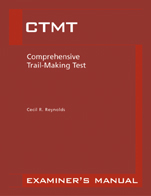Comprehensive Trail-Making Test (CTMT) | |
 | |

Symbol Digit Modalities Test (SDMT) Shipley-2 Extended Complex Figure Test (ECFT) Based on time-tested techinques, the CTMT is a standardized set of five visual search and sequencing tasks that are heavily influenced by attention, concentration, resistance to distraction, and cognitive flexibility (or set-shifting). It is highly useful in the evaluation and diagnosis of brain injury; frontal lobe deficits; problems with psychomotor speed, visual search and sequencing, and attention; and impairments in set-shifting.
| |
The CTMT is for individuals ages 8 through 74. Administration is timed and takes from 5 to 12 minutes. Scoring typically requires just a few minutes more. Normative scores, derived from a nationwide sample of 1,664 people, are provided as percentile ranks and T-scores with a mean of 50 and a standard deviation of 10.
| |
The basic task of trail-making is to connect a series of stimuli (numbers and letters) in a specified order as fast as possible. The score derived for each trail is the number of seconds required to complete the task. The composite score is obtained by pooling T-scores from the individual trails. Although similar, the test’s five trails differ from each other in some significant way. For example, Trail 1 requires the examinee to draw a line connecting the numbers 1 through 25 in order, while Trail 2 presents the same task with 29 distracters on the same page.
| |
The CTMT is extremely sensitive to neurological insult, disease, injury, or dysfunction, including the subtle neuropsychological problems often present in individuals with learning disabilities. |
Component
KIT: Includes 10 Record Booklets; Manual


